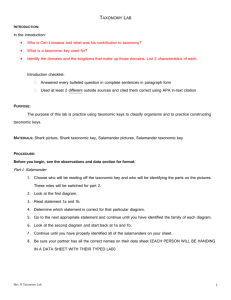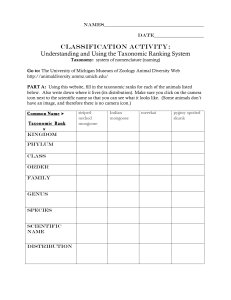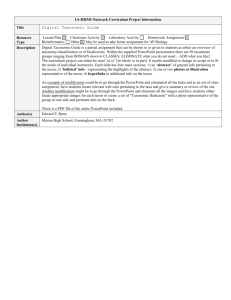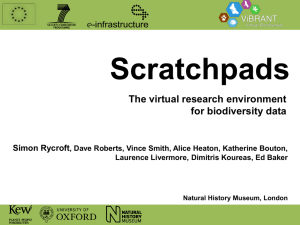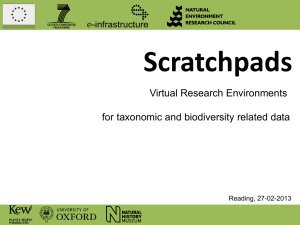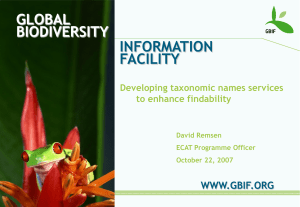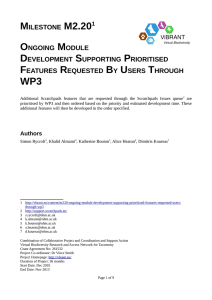Dmitriev Cybertaxonomy and revisionary systematics
advertisement
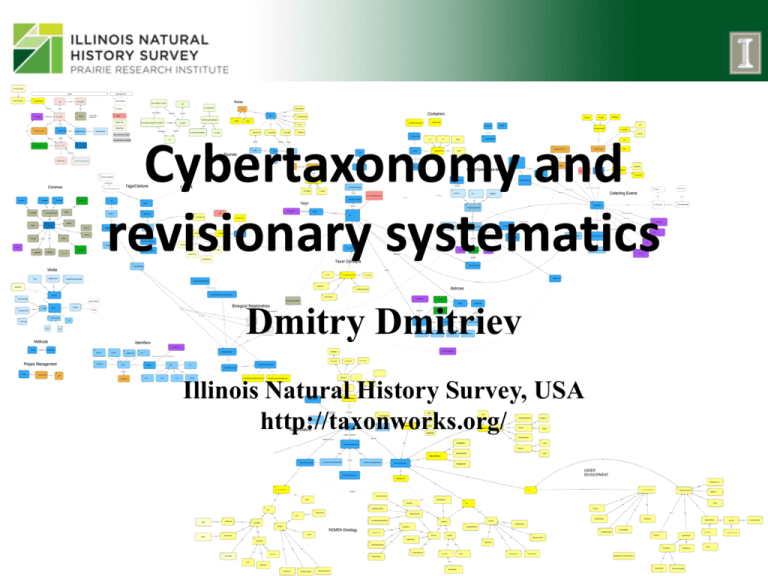
Cybertaxonomy and revisionary systematics Dmitry Dmitriev Illinois Natural History Survey, USA http://taxonworks.org/ Taxonomy • During last 255 years since Linnaeus about 1,800,000 species have been described • Descriptive taxonomy remains very slow and labor intensive process Species accumulation curve •Catalogue of Life provides records for ~1,350,000 species names •Total estimated at 1,800,000 species Number of species described in 10 years periods •Estimated 10,000-15,000 species described each year Species accumulation curve in Cicadellidae Species accumulation curve in Cicadellidae: Typhlocybinae Number of species of Typhlocybinae described in 10 year periods •Dworakowska •Anufriev •Ross •Beamer •Edwards •Osborn •Ribaut •Matsumura •Knull •Zachvatkin •Ross •Young •Dworakowska •Dietrich •Dmitriev Taxonomic impediment • Despite our best efforts, the vast majority (perhaps 90% or more) of the species remain undocumented. • Taxonomists currently describe 15,000 new species per year. • Recent estimates suggest that between 27,000 and 130,000 species are being lost each year to extinction. Taxonomic revision challenges • A taxonomic revision summarizes knowledge about a group of organisms (morphology, distribution patterns, ecological preferences, bioacoustics, molecular variation, synonyms, new species, tools for identifications, etc.) • Efficient management and synthesis of large amounts of nomenclatural, morphological, and distributional data is required. Number of species of Typhlocybinae described in 10 year periods •Dworakowska •Anufriev •Ross •Beamer •Edwards •Osborn •Ribaut •Matsumura •Knull •Zachvatkin •Ross •Young •Dworakowska •Dietrich •Dmitriev Taxonomic revision challenges • When published, a revision provides a snap-shot of the modern knowledge on a group of organisms. • It stimulates further study and species discovery. • It quickly becomes outdated. • 2006: First record of the tribe Erythroneurini from South America. Description of the genus Zyginama • 2008: Revision of the genus Zyginama (70 species) •2013: Three new species of the genus Zyginama from Argentina What is cybertaxonomy? • Technological advances, including relational databases, digital imaging, and Internet dissemination, provide taxonomists with tools to increase both the quality and quantity of such studies. • Cybertaxonomy aims to develop information processing tools that enable taxonomists both to produce traditional taxonomic revisions more rapidly and to develop new models for managing and disseminating taxonomic information. Available applications • • • • 3i SpeciesFile MX Scratchpads 3i - Interactive keys 3i – Pictorial keys 3i - Dichotomous Keys 3i - Taxonomic pages Publications based on 3i 3i - Data Sharing • • • • • Catalogue of Life (CoL) Encyclopedia of Life (EoL) Global Biodiversity Information Facility (GBIF) Discover Life Global Name Architecture (GNA) • Biodiversity Heritage Library SpeciesFile •Designed by David Eades and colleagues in the Illinois Natural History Survey (USA) •Supported by International Orthoptera Society •Online application based on SQL Server database and Visual Basic.net. •Originally designed for the insect order Orthoptera, but later was adopted by researchers working on other insect groups. Species File •System allows storage and retrieval of taxonomic and nomenclatural information with associated images, distribution, and bibliography information. •System strictly enforces the rules of the International Code of Zoological Nomenclature. •Data shared with Catalogue of Life, GBIF MX (MatriX) •Designed by Matt Yoder in Texas A&M University (USA) •Based on MySQL and Ruby on Rails online application. •Originally designed for the insect order Hymenoptera, but later was adopted by researchers working on other insect groups. MX (MatriX) •The system could be used for storage and manipulation of different types of data: bibliographies, images, specimen records, distribution, molecular and morphological information. •Dichotomous and matrix based keys. •Images could be linked to MorphBank. MX (MatriX) •Significant part of MX is an integrated morphological ontology builder which allows to link vocabulary terms to each other, as well as their definitions and illustrations. MX (MatriX) •Dichotomous and matrix based keys. Scratchpads • Based on Drupal content management system • Online application which provides users with templates to enter taxonomy related information in uniform way • Support for classifications, taxon profiles, specimens, literature, images, maps, phenotypic, genotypic & morphometric datasets, keys, phylogenies • Data could be exported in various formats Publishing observations and taxon data Pushed to GBIF & EOL Specimen records & species pages on Scratchpads (requires site registration with GBIF & EOL) Darwin Core Archive (DwCA) Article publishing XML submission, peer review & marked-up publication by Pensoft HTML XML doi:10.3897/zookeys.50.539 PDF Paper assembled from Scratchpad database Published in Zookeys & Phytokeys TaxonWork: new development TaxonWork: new development Sources Georeferences People Collecting Events Media Specimens Taxon Concepts Matrices Taxon Name Alternative Classification Interactive Keys Name Statuses Relationships TaxonWorks: Nomen Ontology https://github.com/SpeciesFileGroup/nomen TaxonWorks: Nomen Ontology https://github.com/SpeciesFileGroup/nomen TaxonWork: new development Acknowledgements •Collaborators: Christopher Dietrich, Roman Rakitov, Daniela Takia, Sindhu Krishnankutti, Doris Lagos, David Eades, Matt Yoder, Edward DeWalt, Alexey Solodovnikov, Yalin Zhang, Richard Pile, and many others. •Grant support: NSF, EoL.

